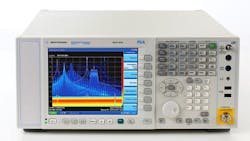Improved Real-Time Spectrum Analysis Reveals The Mysteries Of RF Signals
Wireless systems continue to get more complex with their high speeds, wide bandwidth, short bursts, frequency hopping, and sophisticated modulation schemes, making them more difficult than ever to test. Measuring and detecting signals from these systems has become the number one challenge of the design and test engineer.
The solution to this problem is a high-performance spectrum analyzer with the appropriate frequency range, bandwidth, and responsiveness. Agilent Technologies’ Real-Time Spectrum Analysis (RTSA) option for its new and existing PXA signal analyzers gives engineers a real-time view that resolves many testing problems.
Agilent’s PXA top-of-the-line signal analyzers feature upper frequency ranges from 3.6 GHz to 50 GHz (see the figure). With an external mixer, it can display signals out to 325 GHz. The RTSA option brings real-time capture and measure capability to the PXA line. Real-time capability allows the user to see, capture, and display highly elusive signals, known or unknown. The PXA instruments use high-speed ASICs and FPGAs to convert sampled signal data into signal spectra with fast Fourier transforms (FFTs), and this data is then combined to generate meaningful displays.
The real-time spectrum analyzer (RTSA) option for the Agilent PXA lets users capture, see, and understand complex and fleeting RF signals at frequencies to 50 GHz with a bandwidth to 160 MHz.
Real-time as defined here means that the input signals are captured and digitized as well as processed immediately for some measurement or trigger operation. Signals are sampled and computed concurrently in an RTSA, giving it five key attributes: gap-free analysis, high-speed measurements, consistent measurement speed, advanced composite displays, and frequency-mask triggering (FMT).
The RTSA option offers:
- Wider bandwidth: The RTSA is offered two wide bandwidth formats, 85 MHz and 160 MHz.
- Improved dynamic range: The spurious-free dynamic range is as high as –75 dB across the full 160-MHz bandwidth, allowing users to find and see intermittent signals even in the presence of larger signals.
- High sensitivity: Input sensitivity is –157 dBm at 10 GHz with no preamp, enabling users to see closely spaced or intermittent signals. Phase noise is –132 dBc at 1 GHz with 10-kHz offset.
- Probability of intercept (POI) capability: Signals as short as 3.57 µs can be detected, captured, seen, and understood.
- Frequency-mask triggering (FMT): Users can set up a spectrum mask that initiates triggering when a signal enters the mask region. This ability is a real asset when searching for a specific signal.
Furthermore, you can use Agilent 89600 VSA software to add vector signal analysis and demodulation along with real-time spectrum analysis. The Agilent PXA RTSA is applicable to any wireless application but is especially useful with the complex signals of radar, electronic warfare, and military communications.
The N9030A 3.6-GHz PXA signal analyzer with the real-time spectrum analyzer option and 160-MHz bandwidth starts at $96,304. The RTSA option prices alone are $7224 for 85-MHz bandwidth and $10,320 for 160-MHz bandwidth.
Agilent Technologies
About the Author

Lou Frenzel
Technical Contributing Editor
Lou Frenzel is a Contributing Technology Editor for Electronic Design Magazine where he writes articles and the blog Communique and other online material on the wireless, networking, and communications sectors. Lou interviews executives and engineers, attends conferences, and researches multiple areas. Lou has been writing in some capacity for ED since 2000.
Lou has 25+ years experience in the electronics industry as an engineer and manager. He has held VP level positions with Heathkit, McGraw Hill, and has 9 years of college teaching experience. Lou holds a bachelor’s degree from the University of Houston and a master’s degree from the University of Maryland. He is author of 28 books on computer and electronic subjects and lives in Bulverde, TX with his wife Joan. His website is www.loufrenzel.com.

